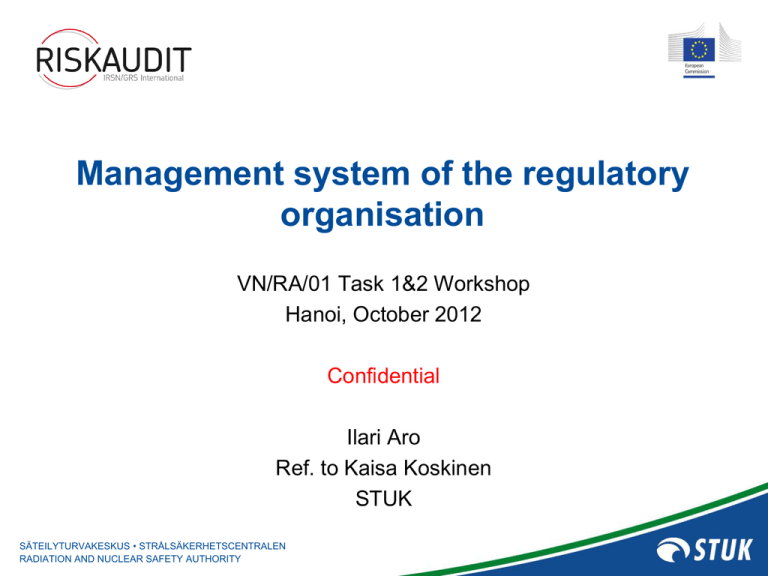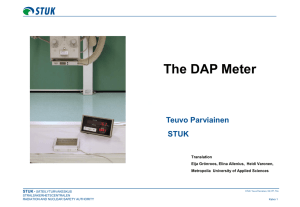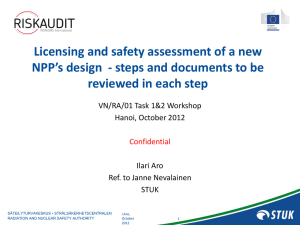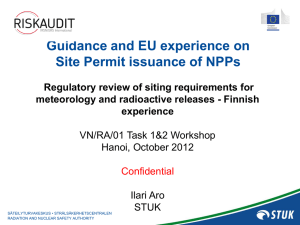STUK`s Management System
advertisement

Management system of the regulatory organisation VN/RA/01 Task 1&2 Workshop Hanoi, October 2012 Confidential Ilari Aro Ref. to Kaisa Koskinen STUK SÄTEILYTURVAKESKUS • STRÅLSÄKERHETSCENTRALEN RADIATION AND NUCLEAR SAFETY AUTHORITY Content • • • • • IAEA safety standards and guidance Regulatory processes and procedures Quality manual Self-assessment and audits External assessment SÄTEILYTURVAKESKUS • STRÅLSÄKERHETSCENTRALEN RADIATION AND NUCLEAR SAFETY AUTHORITY 2 Requirements for Regulatory Body’s Management System • IAEA has published a requirement document GSR Part 1 Governmental, Legal and Regulatory Framework for Safety: Requirement 19: The management system of the regulatory body The regulatory body shall establish, implement, and assess and improve a management system that is aligned with its safety goals and contributes to their achievement. 4.14. The regulatory body shall establish and implement a management system whose processes are open and transparent. The management system of the regulatory body shall be continuously assessed and improved. SÄTEILYTURVAKESKUS • STRÅLSÄKERHETSCENTRALEN RADIATION AND NUCLEAR SAFETY AUTHORITY 3 Requirements for Regulatory Body’s Management System con’t 4.15. The management system of the regulatory body has three purposes: (1) The first purpose is to ensure that the responsibilities assigned to the regulatory body are properly discharged. (2) The second purpose is to maintain and improve the performance of the regulatory body by means of the planning, control and supervision of its safety related activities. (3) The third purpose is to foster and support a safety culture in the regulatory body through the development and reinforcement of leadership, as well as good attitudes and behavior in relation to safety on the part of individuals and teams. SÄTEILYTURVAKESKUS • STRÅLSÄKERHETSCENTRALEN RADIATION AND NUCLEAR SAFETY AUTHORITY 4 Requirements for Regulatory Body’s Management System con’t 4.16. The management system shall maintain the efficiency and effectiveness of the regulatory body in discharging its responsibilities and performing its functions. This includes the promotion of enhancements in safety, and the fulfillment of its obligations in an appropriate, timely and cost effective manner so as to build confidence. 4.17. The management system shall specify, in a coherent manner, the planned and systematic actions necessary to provide confidence that the statutory obligations placed on the regulatory body are being fulfilled. Furthermore, regulatory requirements shall be considered in conjunction with the more general requirements under the management system of the regulatory body; this helps to prevent safety from being compromised. SÄTEILYTURVAKESKUS • STRÅLSÄKERHETSCENTRALEN RADIATION AND NUCLEAR SAFETY AUTHORITY 5 Requirements for Regulatory Body’s Management System con’t • IAEA has published a requirement document GS-R-3 Management Systems for Facilities and Activities’ which is applicable for RB’s • IAEA has also published guidance (GS-G-3.1) how to apply all the requirements Revision of GS-R-3 General Safety Requirements Part II: GS R Part II-Leadership and Management for Safety • Will meet long term structure of SS with General and Specific Safety Requirements • Objective and scope are “not” fundamentally changed – More focus on leadership and responsibility for safety and safety culture SÄTEILYTURVAKESKUS • STRÅLSÄKERHETSCENTRALEN RADIATION AND NUCLEAR SAFETY AUTHORITY 6 IAEA Safety Standards SÄTEILYTURVAKESKUS • STRÅLSÄKERHETSCENTRALEN RADIATION AND NUCLEAR SAFETY AUTHORITY Source: Pal Vince 7 GS-R-3 Safety Requirements Chapter 2 Management System • general requirements • safety culture • grading the application of management system requirements • documentation of the management system SÄTEILYTURVAKESKUS • STRÅLSÄKERHETSCENTRALEN RADIATION AND NUCLEAR SAFETY AUTHORITY 8 GS-R-3 Safety Requirements Chapter 3 Management Responsibility • management commitment • stakeholder satisfaction • organisational policies • planning • responsibility and authority for the management system SÄTEILYTURVAKESKUS • STRÅLSÄKERHETSCENTRALEN RADIATION AND NUCLEAR SAFETY AUTHORITY 9 GS-R-3 Safety Requirements Chapter 4 Resource Management • provision of resources • individual competence • infrastructure and work environment SÄTEILYTURVAKESKUS • STRÅLSÄKERHETSCENTRALEN RADIATION AND NUCLEAR SAFETY AUTHORITY 10 GS-R-3 Safety Requirements Chapter 5 Process implementation • developing processes • process management • generic management process – – – – – – document control control of products control of records purchasing communication managing organisation change SÄTEILYTURVAKESKUS • STRÅLSÄKERHETSCENTRALEN RADIATION AND NUCLEAR SAFETY AUTHORITY 11 GS-R-3 Safety Requirements Chapter 6 Measurement, Assessment and Improvement • monitoring and measurement • self-assessment • independent assessment • management system review • non-conformances, corrective and preventive actions • improvement SÄTEILYTURVAKESKUS • STRÅLSÄKERHETSCENTRALEN RADIATION AND NUCLEAR SAFETY AUTHORITY 12 GS-G-3.1 Generic Safety Guidance Thematic guidance for Management Systems • Application of the Management System for Facilities and Activities • Generic information and examples to aid understanding and implementation of Management System requirements Provides guidance on HOW TO comply with (i.e. to implement) GS-R-3 requirements • Development of the management system • Exercise of management responsibility • Management of Resources • Development and implementation of processes • Measurement, assessment and review of performance and of the management system, • … etc. SÄTEILYTURVAKESKUS • STRÅLSÄKERHETSCENTRALEN RADIATION AND NUCLEAR SAFETY AUTHORITY 13 STUK’s Management System SÄTEILYTURVAKESKUS • STRÅLSÄKERHETSCENTRALEN RADIATION AND NUCLEAR SAFETY AUTHORITY 14 Historical Background of the STUK Management System • STUK has had a management system and written procedures to guide staff members from the first beginning of its establishment. • A systematic approach of the internal quality system was firstly established at the beginning of 90’s for the regulatory oversight of nuclear facilities. • The quality system was based on existed principles and routines. Good practices were adopted when they were considered applicable. • The systematic approach was established voluntarily without any external pressure. SÄTEILYTURVAKESKUS • STRÅLSÄKERHETSCENTRALEN RADIATION AND NUCLEAR SAFETY AUTHORITY 15 Historical Background con’t • In 1997, STUK decided to extend the systematic quality approach to cover all STUK operations. • Self assessment of the STUK-QMS has been carried out several times: – the Finnish Quality Award Criteria (MB), EFQM, ISO 9001 & ISO 9004 (1995 & 2000), IAEA-TECDOC-1090. • IRRT Mission was conducted in March 2000 and the Follow-up Mission in September 2003. • IRRS Mission will be conducted in October 2012 • National laboratory activities of STUK • • ISO 17025 accredited activities STUK does not have ISO 9001 Certification – mandate to do work has been granted through the legislation – no obligation to demonstrate quality management SÄTEILYTURVAKESKUS • STRÅLSÄKERHETSCENTRALEN RADIATION AND NUCLEAR SAFETY AUTHORITY 16 Basic framework for the STUK’s Management System • Sound legislation and clearly defined mandate for STUK. • Appropriate organisation as well as sufficient human and financial resources that are built according to the duties and goals of STUK. • Clear definition of mission, organisational values, vision and strategy. • Clear definition of functions and working processes (still under processing). • Clear definition of duties, responsibilities and authorities of each organisational unit and employee. • Quality policy confirmed by the top management. • Professional competence covers all necessary key spheres. • Most of the staff members have a high quality awareness, motivation and commitment to continuous improvement. SÄTEILYTURVAKESKUS • STRÅLSÄKERHETSCENTRALEN RADIATION AND NUCLEAR SAFETY AUTHORITY 17 Framework for the quality and safety management •regulations •stakeholders •nuclear programme •human and financial resources •working conditions •etc. Quality Documents Operations •quality policy •planning •managerial guides •work execution •work instructions •assessment and measurement •work assignments •improvement and development •records SÄTEILYTURVAKESKUS • STRÅLSÄKERHETSCENTRALEN RADIATION AND NUCLEAR SAFETY AUTHORITY 18 Implementation of the Management System Prerequisites for quality and safety management - Regulations 1. Setting and - Quality Manuals updating - Working environment objectives - Resources - etc 4. Improvement and development Interactive cooperation 3. Assessment and measurement SÄTEILYTURVAKESKUS • STRÅLSÄKERHETSCENTRALEN RADIATION AND NUCLEAR SAFETY AUTHORITY 19 A. Long-term focus B. Annual focus C. Day-to-day focus 2. Work execution Framework of the STUK QMS Framework for the Quality and Safety Management Quality Manuals available for STUK operations 1. STUK Quality Manual - Regulations Manuals common to different STUK level operations - Quality Manuals 2. Personnel Administration - Resources 3. Financial Administration - Working environment 4. Information Management - etc 5. Emergency Preparedness 6. Communications Quality Manuals relating to specific organizational sectors 7. YTV Quality Manual (Nuclear Reactor Regulation (YTO) and Nuclear Waste and Materials Regulation (YMO)) 8. STO Quality Manual (Radiation Practices Regulation) 9. TKO Quality Manual (Research and Environmental Surveillance) 10. HAE Quality Manual (Administration and special units) SÄTEILYTURVAKESKUS • STRÅLSÄKERHETSCENTRALEN RADIATION AND NUCLEAR SAFETY AUTHORITY 20 STUK Guides 1. Quality system STUK 1.1 Quality Policy STUK 1.2 Description of Quality system STUK 1.3 Model of Quality Manual STUK 1.4 Updating and Distribution of Quality Manual Guides 2. Organization and management STUK 2.1 Rules of Administration STUK 2.2 Organization STUK 2.3 Management by results System STUK 2.4 Rules of Finance STUK 2.5 Board of Directors STUK 2.6 Internal working groups STUK 2.7 Projects SÄTEILYTURVAKESKUS • STRÅLSÄKERHETSCENTRALEN RADIATION AND NUCLEAR SAFETY AUTHORITY 21 3. Core Processes STUK 3.1 Regulatory control STUK 3.2 Research STUK 3.3 Development of Regulations and Guides STUK 3.4 Emergency preparedness STUK 3.5 Shared cost actions STUK 3.6 Expert services STUK 3.7 Maintenance of Measurement Standards (Radiation metrology) STUK 3.8 External communications STUK 3.9 EnvironmentAL Radiation Monitoring STUK Guides 4. Support Processes STUK 4.1 IT Management STUK 4.2 Financial Management STUK 4.3 Administration and Internal Services STUK 4.4 Procurement STUK 4.5 Agreements STUK 4.6 Supervision of STUK’s equipment STUK 4.7 Processing and Archiving of Documents STUK 4.8 Facilities and Access Control STUK 4.9 Document Preparation STUK 4.10 Publicity of Documents and Data STUK 4.11 Processing of Personnel Data STUK 4.12 Classification and Processing of Confidential Documents STUK 4.13 Employee Inventions STUK 4.14 Copyrights STUK 4.15 Use of Radiation in STUK SÄTEILYTURVAKESKUS • STRÅLSÄKERHETSCENTRALEN RADIATION AND NUCLEAR SAFETY AUTHORITY 22 STUK 4.16 Radiation Safety Glossary STUK 4.17 Participation in Standardisation Work 5. Personnel STUK 5.1 Principles of Personnel Administration STUK 5.2 Competence Management STUK 5.3 Pay System STUK 5.4 Equality Plan STUK 5.5 Co-operation Agreement STUK 5.6 Internal Communications STUK 5.7 Safety at work STUK 5.8 Addressing Failure to Fulfil Official Duties 6. Quality Management STUK 6.1 Internal Audits STUK 6.2 Risk Management STUK 6.3 Quality Self-Assessment STUK 6.4 Reviews and Corrective Measures STUK 6.5 Customer and Stakeholder Feedback STUK’s Quality Policy • Challenged by vision, obliged by values • Vision • Values • • • • • • • Safety and quality are emphasised in operation Regulatory oversight ensures safety Research produces new information Expert services enhance safety Communication is active and open Provision is made for emergencies Sound prerequisites for operation are provided • • • • • • • Quality management Co-operation between management and personnel Internal control Personnel policy Financial administration Information technology Internal services SÄTEILYTURVAKESKUS • STRÅLSÄKERHETSCENTRALEN RADIATION AND NUCLEAR SAFETY AUTHORITY 23 YTV Quality Manual 1. Quality system 2. Organisation and leadership 3. Preparation and execution of regulations 4. Regulatory oversight of NPPs 5. Regulatory oversight of nuclear waste and nuclear materials 6. Decision making and execution 7. Public communications 8. Supportive actions SÄTEILYTURVAKESKUS • STRÅLSÄKERHETSCENTRALEN RADIATION AND NUCLEAR SAFETY AUTHORITY 24 Process Approach • Process approach is widely used • Processes are divided into main processes and support processes (internal) • There are 11 main processes (each containing several processes and sub-processes) and 8 support processes (each containing several processes) • For each process there is a process description (guide) and a flow-chart SÄTEILYTURVAKESKUS • STRÅLSÄKERHETSCENTRALEN RADIATION AND NUCLEAR SAFETY AUTHORITY 25 MANAGEMENT PERSONNEL ADMINIST. PROCESS MAPFINANCIAL DATA ADMINIST. ADMINIST. SUPPORT PROCESSES CUSTOMER AND SOCIETY NEEDS REGULATORY CONTROL OF NUCLEAR WASTE MANAGEMENT REGULATORY CONTROL OF NON-PROLIFERATION OF NUCLEAR WEAPONS REGULATORY CONTROL OF THE USE OF RADIATION METROLOGY RESEARCH ENVIRONMENTAL SURVEILLANCE EXPERT SERVICES EMERGENCY PREPAREDNESS RULE MAKING OUTCOMES OF CORE PROCESSES REGULATORY CONTROL OF NUCLEAR POWER PLANTS COMMUNICATION COMPETENCE INTERNAL SERVICES SÄTEILYTURVAKESKUS • STRÅLSÄKERHETSCENTRALEN RADIATION AND NUCLEAR SAFETY AUTHORITY 26 SURVEYS SUPPORTING REGULATORY ACTIVITIES DEVELOPMENT OF EMERGENCY PREPAREDNES S SUPPORT PROCESSES Nuclear reactor regulation Rule Making Oversight of New Power Plant Projects and Plant Modifications • Legislation • YVL-guides • Int. statements Decision Making and Enforcement • Document handling • Contracted services • Enforcement Inspection programmes • Periodic inspection programme (KTO) • Inspection programme for construction (RTO) • Inspections required in YVL-guides Safety Analysis Oversight of and Assessment Operations • Conceptual design of the plant • Conceptual design of the systems • Systems design • Components and structures design • Manufacturing and construction • Validation and suitability • Inspections of components and structures • Commissioning • Modifications • Deterministic safety analysis • Compliance with tech specs Oversight of Management in Regulated Organisations •Probabilistic safety analysis (PRA) • Incidents • Safety management • Outage management • Management systems and QMS • Maintenance and ageing management • Training and qualification of personnel • Safety performance indicators; analysis and feedback • Fire Protection • Radiation protection • Emergency preparedness • Security • Operational experiences • Manufacturers of nuclear pressure equipments • Nuclear liability • Event investigation • Testing- and inspection organisations Safety Assessment • Statement for decision-in-principle, construction and operating license, periodic safety review • Annual assessment of the safety of NPPs • Safety assessment required in CNS SÄTEILYTURVAKESKUS • STRÅLSÄKERHETSCENTRALEN RADIATION AND NUCLEAR SAFETY AUTHORITY 27 Setting and updating objectives 1. Management objectives are set in two time scales: – – strategic planning – cycles of four years annually 2. Implementation of the STUK Strategy is supported with more detailed Action Plans – – Action Plans are written for each of the 12 STUK’s Result Areas by the persons responsible for the respective areas Regulation of Nuclear Power Plants is largest of these Result Areas. 3. The input for the strategic plan comes from three main sources: – information on future plans and programs of the main stakeholders – – such as NPP licensees, users of radiation, Finnish Government and European Union a SWOT-analysis of other known and potential changes in the operating environment (SWOT = strengths, weaknesses, opportunities, threats) improvement and development needs indicated by the systematic assessment and measurement SÄTEILYTURVAKESKUS • STRÅLSÄKERHETSCENTRALEN RADIATION AND NUCLEAR SAFETY AUTHORITY 28 Setting and updating objectives .... 4. Annual planning is started with guidance given by the management, based on – Strategic Plan – need of development identified from the feedback loop – plans and expectations of stakeholders 5. Planning process goes firstly top down involving meetings of organizational units and then bottom up through systematic face-toface discussions at all levels between the supervisors and their subordinates. 6. Annual work plan provides performance and development goals for each person, for each organizational unit, and for the entire STUK. Among the goals are – output of the work – development of the work processes – development of the staff knowledge and skills 7. Performance goals and annual targets of STUK are written in an agreement that the management signs with the Ministry of Social Affairs and Health. SÄTEILYTURVAKESKUS • STRÅLSÄKERHETSCENTRALEN RADIATION AND NUCLEAR SAFETY AUTHORITY 29 Conduct of works (work execution) 1. Quality Policy – management view on high quality in each of the main work areas 2. Tasks and responsibilities of all organizational units and persons; Cross-organisational working is preferred (team working between organisational units without involving supervisors regularly in this team working); 3. Practices of management and internal communications at all levels 4. Descriptions of STUK’s work processes and guidance for managing those processes 5. Comprehensive set of standing orders, guides, and procedures that give instructions for all STUK’s operations, including both administration and professional work 6. Each employee has just one organisational position but several roles in doing work; Each employee is responsible for a work of his/her own; The high quality of work is important to achieve at the first attempt in order to avoid unnecessary loading of other workers. SÄTEILYTURVAKESKUS • STRÅLSÄKERHETSCENTRALEN RADIATION AND NUCLEAR SAFETY AUTHORITY 30 Assessment, Measurement and Improvement Internal assessment – – – – – systematic follow-up of achievements against the agreed annual targets cross-audits conducted by staff members according to annual audit programme self-assessment carried out in internal workshops annual upper management reviews staff surveys every two years (on staff engagement, motivation, satisfaction, etc.), and – annual Report to the Ministry on work results and developments, including assessment against agreed targets and other performance indicators. External assessments are conducted by international and national peers, including the following: – regulatory activities were evaluated by an IAEA’s IRRT mission in year 2000 and a follow-up in 2003 – IRRS mission in Finland October 2012 – IPPAS mission in Finland in summer 2009 – Assessment of research activities – one or two topical audits every year by external experts who are working on similar issues. SÄTEILYTURVAKESKUS • STRÅLSÄKERHETSCENTRALEN RADIATION AND NUCLEAR SAFETY AUTHORITY 31 Assessment of stakeholder interfaces 1. Annual agreement and discussions between STUK and the Ministry of Health and Social Affairs 2. Thesis on the co-operation between STUK and Finnish utilities 3. Independent study on the Finnish regulations whether they are too prescriptive or not 4. Annual post-interviews with the selected utility staff members are conducted relating to the Inspection Programs 5. Investigation of selected operational events/issues (the latest one: Violations of and exemptions from the TechSpecs); except utility operations also STUK operations are investigated in these reviews 6. A number of complaints from the stakeholders are followed 7. A general follow-up of the mass media EFQM definition of “Stakeholders”: • “All those who have an interest in an organisation, its activities and its achievements. These may include customers, partners, employees, shareholders, owners, government, and regulators.” SÄTEILYTURVAKESKUS • STRÅLSÄKERHETSCENTRALEN RADIATION AND NUCLEAR SAFETY AUTHORITY 32 Face-to-face discussions • Face-to-face discussions (supervisor/subordinate discussions; summingup discussions) is a mandatory process in STUK. Each supervisor shall conduct at least once a year a discussion separately with each of his/her subordinates. • In addition to reviewing the results of the ongoing year and determining the targets of the forthcoming year, the discussions shall cover the following topics: • training • work satisfaction • co-operation satisfaction • mutual feedback. • The contents and principles have been described in the Guide STUK 2.3. • Main results of these discussions are utilised in the Management Review and in drawing up an Annual Action Plan. SÄTEILYTURVAKESKUS • STRÅLSÄKERHETSCENTRALEN RADIATION AND NUCLEAR SAFETY AUTHORITY 33 Management review • Management review carried out in the end of each year both at departmental and STUK levels has been experienced very useful. • The below list is composed of data included in Annual Management Review: • Actions agreed in the previous management review (backlog of recommendations) • Conclusions of supervisor/subordinate discussions • Summary Reports on overall assessment of different regulatory sectors (rule making, safety analyses, performance indicators etc.) • Self-assessment reports (based on EFQM Business Model) • Internal and external audit reports • Assessment reports relating to STUK/stakeholder interactions • Outcome of the development seminars • Conclusions of the leadership enquiries • Reports of quality deviations • Stakeholder feedback (complaints and positive feedback from the stakeholders including other departments and top management). SÄTEILYTURVAKESKUS • STRÅLSÄKERHETSCENTRALEN RADIATION AND NUCLEAR SAFETY AUTHORITY 34 Conclusions • An honest top management commitment (important that talks and actions comply with each others) is a key factor of effective QMS implementation; • High motivation of the staff and the top management to achieve objectives is of vital importance; • Clear rules of the game obligate staff members but also protect them in case of confusions; • Awareness of good management tools (EFQM, Balanced Scorecard, SWOT analyses, information management etc.) create effective means to manage activities and to lead people; • Transparency (internal guides are submitted to the operators for information) gives a good basis for co-operation with the regulated organisations. SÄTEILYTURVAKESKUS • STRÅLSÄKERHETSCENTRALEN RADIATION AND NUCLEAR SAFETY AUTHORITY 35








![The Politics of Protest [week 3]](http://s2.studylib.net/store/data/005229111_1-9491ac8e8d24cc184a2c9020ba192c97-300x300.png)
